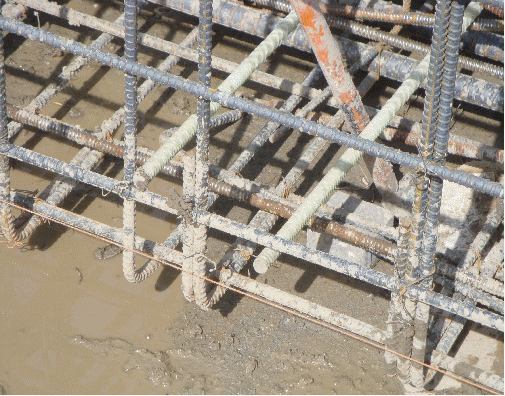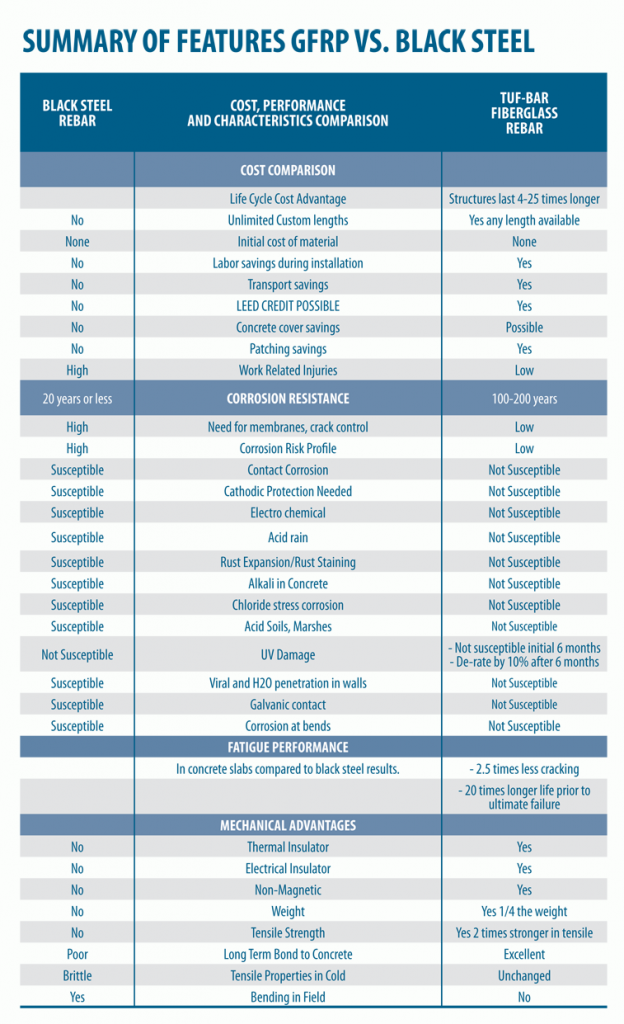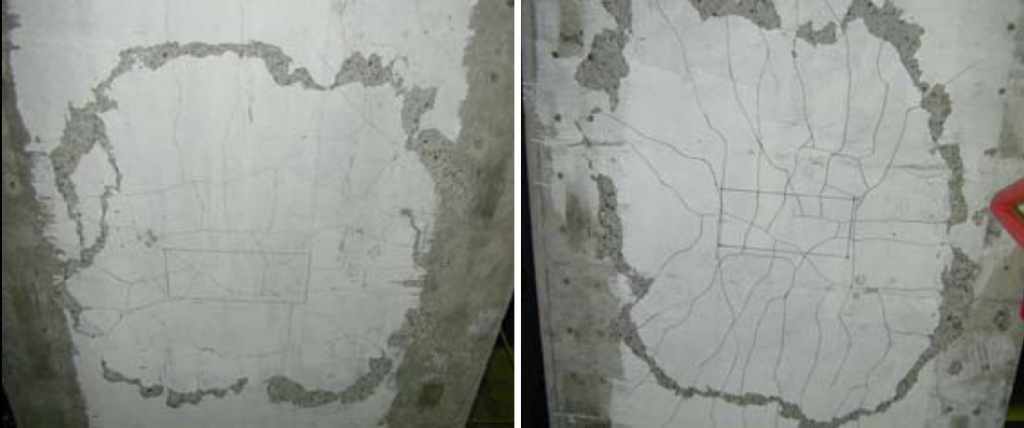GR. 40 Plain Black Steel versus Fiberglass Rebar (GFRP)
Black steel is inexpensive and plentiful. It’s a great reinforcement to use if you are not responsible for the long-term maintenance of a concrete structure.
As you can see from this photo (green bars are GFRP) black steel essentially has no corrosion resistance, frequently it comes to the job site already rusting. Often even excessively rusted rebar is sold to the end user. Rust has been called concretes cancer; it degrades frequently and ugly rust stains often appear on surfaces of structures reinforced with it.
Structures built with black steel generally need some rehabilitation in as little as 5 to 10 years and frequently need major rehabilitation within 20 years.
No corrosion effect has been detected on GFRP; conservative estimates indicate fiberglass reinforced concrete structures will last longer than 100 years. Properly reinforced GFRP concrete slabs exposed to heavy fatigue loads (like driveways, bridge decks) will have less cracking and are projected to last up to 20 times longer than similar structures reinforced with conventional black steel.

- Rusted new rebar versus unrusted GFRP form ties
The prime reason for using GFRP is for concrete longevity. While black steel is inexpensive, it will eventually destroy your concrete. Using dirty oil in your new vehicle makes no sense… nor does it make sense to inject cancer cells into a healthy body. Many governments, municipalities and businesses have concluded that they can no longer afford the short or long term costs associated with black steel. Placing unprotected, rusty rebar in new concrete structures is being questioned and eliminated in many parts of North America.
What does TUF-BAR™ Fiberglass Rebar (GFRP) cost versus Grade 40 Black Steel Rebar?
- Cost Comparison GFRP to Plain Black Steel October 2009
The largest price variance between GFRP and black steel occurs when you compare the lowest grade black steel to rebar GFRP rebar
Depending on volume, a #3 10 mm plain black steel Grade 40 rebar can be 1/3 the cost of a #3 10mm fiberglass rebar. As the diameter of the bars increase this gap narrows to a point where a #8 22 mm plain black steel bar is only slightly less expensive than #8 22 mm fiberglass rebar.
In some applications less concrete cover and reduced water proofing costs result in lower initial project cost.
What would it cost to build a small structure with GFRP versus Black Steel?
Using a high price for GFRP and very low price for black steel rebar, the cost to build a 20 ft. x 20 ft. garage pad with Black Steel versus GFRP would be as follows:
- Grade 40 Black Steel Concrete deck $4,000-$6,000
- GFRP reinforced concrete deck $4,400-$6,400
Life Cycle Costs
Many life cycle costs studies comparing black steel to GFRP have been completed. The consistently conclude that the cost to protect, preserve and repair black steel in concrete is very high. So high, in fact, that even free black steel rebar still has a higher installed cost than GFRP in some applications.
How can this be?
Consider our garage pad example.
If the owner wanted to extend life of the concrete he has a number of options open and they are expensive:
- More concrete cover going to a thicker slab
- High performance concrete
- Concrete corrosion preventative additives
- Add a protective membrane
Cracking is difficult to control in any structure. The risk of the measures used to protect black steel failing if cracks occur in the concrete is very high. As soon as these measures fail the steel corrosion cycle starts again.
Although proven to extend the life of concrete when intact. Commercial membranes are not usually used in garage pads because of the expense.

If we take the garage pad as an example; a commercial membrane increases the cost of the black steel pad by $600 to $3,300. The pad would now costs from $4,999 to $9,700 depending on labor costs and the quality of the membrane. The black steel reinforced pad will cost $600 to $3,300 more than a GFRP pad to complete.
The membrane cost can exceed the cost of the reinforcement. The structure will still be subject to fatigue cracking over time.
Fatigue Effect
Bridge deck studies simulating heavy traffic over concrete slabs have concluded that properly reinforced GFRP rebar slabs experience:
1) Experience 2.5 times less cracking than steel reinforced slabs
2) Last 20 times longer than steel reinforced slabs when exposed to heavy fatigue loads
Researchers believe that this is due to the differences in the modulus of elasticity between GFRP and steel. GFRP has a modulus very similar to concrete. Steel’s modulus is many times higher. Steel is less forgiving than GFRP. Damage occurs to concrete as steel bends within the pour.
Conclusion:
Fiberglass rebar (GFRP) is a cost effective way to:
- Eliminate fundamental and expensive repair problems created by black steel reinforcement.
- Maintain cosmetically attractive structures over time (less cracking and ugly rust staining) resulting in higher property resale values.
- Reduce concrete cover and corrosion protection measures taken to protect black steel rebar.
- Ensure your structures will last up to 4 times longer eliminating expensive capital expenditures over time.
- Make slabs exposed to cyclic loads last 20 times longer than steel reinforced slabs.







